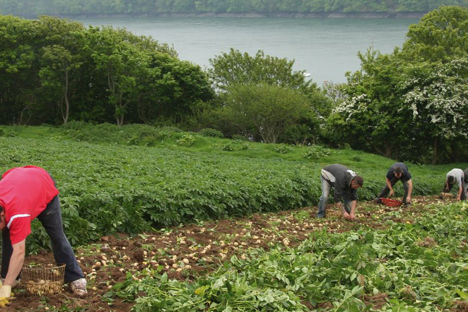
Let’s hear it for… Pembrokeshire Earlies
Pembrokeshire Earlies have been grown in the coastal county for hundreds of years, and are well loved all over Wales and the surrounding area. As one of only four products from Wales with protected status, there is an increasing demand for Pembrokeshire Earlies from chefs and home cooks alike across the UK. But what are Pembrokeshire Earlies? And what is it about these distinctive little potatoes that makes them so popular?
Let’s hear it for… Pembrokeshire Earlies
Pembrokeshire Earlies have been grown in the coastal county for hundreds of years, and are well loved all over Wales and the surrounding area. As one of only four products from Wales with protected status, there is an increasing demand for Pembrokeshire Earlies from chefs and home cooks alike across the UK. But what are Pembrokeshire Earlies? And what is it about these distinctive little potatoes that makes them so popular?
What are Pembrokeshire Earlies?
Pembrokeshire Earlies are small, bright new potatoes grown exclusively in the unique coastal climate of Pembrokeshire, Wales. The first crop of Pembrokeshire Earlies, usually available by late May, are so delicate that they are almost always picked by hand to avoid being damaged by machinery - their early harvest results in a soft, thin skin meaning farmers tend to sell them still coated in soil to keep the potatoes intact.
Potatoes picked at this early stage have a wonderful, subtle flavour but - as with most new potatoes - require a little more care than the robust maincrop varieties available in late summer and early autumn. When purchased they should be washed and stored in the fridge (contrary to all our prior potato storage instincts) until required to keep the potatoes at their best.
With a distinctive, almost nutty flavour these little potatoes lend themselves extremely well to lighter dishes, and require very little seasoning to enhance their natural taste. Try using Pembrokeshire Earlies in a creamy potato salad with spring onion and chives, roasted with olive oil and rosemary until golden or simply served with salt, butter and fresh cut herbs. The latter in particular would pair perfectly with barbecued meat or pan-fried fish. For a more adventurous dish, Frances Atkins of the Yorke Arms combines Pembrokeshire Earlies with herbs, butter and seasonal vegetables into a flavour-packed potato terrine, complementing what she identifies as their ‘lovely, fresh, earthy taste’.
What’s all the fuss about?
In 2014 the European Commission recognised Pembrokeshire Earlies as an outstanding regional product, awarding Protected Geographical Indication (PGI) status. When produce is awarded protected status it does not merely refer to the location where they are made or grown, but also the methods and ingredients involved. In part a promise of quality for consumers, it also serves as an acknowledgement to the producers that their skill and technique – as well as their sensitive understanding of the geographical climate – are vital to the final outcome of the product.
In the case of Pembrokeshire Earlies growing and harvesting have been taking place in the Welsh county since the 1700s, using special methods honed after centuries of experience. Potatoes are frost-averse, making the Pembrokeshire coast – warmed by the Gulf Stream and benefiting from rich, fertile soil – the perfect climate for their growth. Planted in late February once the soil is free from frost, harvesting begins (initially by hand) in May, continuing through until the end of the summer.
Pembrokeshire Earlies are one of four Welsh products with protected status - along with Welsh Lamb, Welsh Beef and Anglesey Sea Salt - and their popularity is a testament to Britain’s growing appreciation of quality local produce. Overall the UK has 65 products with protected status, ranging from Scotch whisky to Cornish pasties, covering a variety of agricultural and artisanal produce. While we may be slightly lagging behind France and Italy – which have 216 and 267 protected products respectively – there’s no doubt that ours is still a formidable list of outstanding regional produce.


